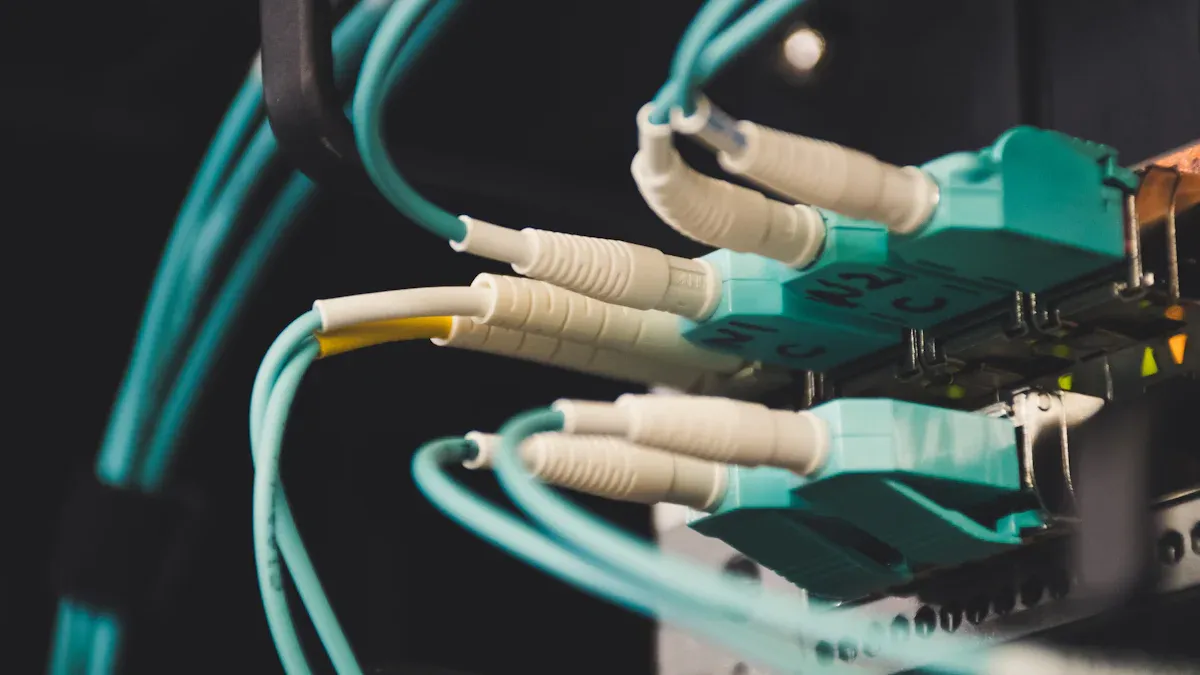ESTEL Telecom Rectifiers Driving 5G Network Efficiency

The rapid expansion of 5G networks brings unique challenges, particularly in managing power density and energy efficiency. ESTEL telecom rectifiers stand out as a critical solution. These devices ensure reliable network performance while keeping energy consumption and operational costs in check.
Studies show that reusing existing infrastructure can reduce capital expenses significantly, making ESTEL rectifiers a cost-effective choice.
High efficiency minimizes heat generation, lowering operational expenses—a vital factor given 5G's higher power demands compared to 4G.
Simplified maintenance reduces costs, especially with pinpoint 5G deployments.
Did you know? Telecom rectifiers like ESTEL's are built to last over 10 years, with a mean time between failures exceeding 1,000,000 hours, meeting the Telcordia SR-332 standard. This ensures long-term reliability, even for smaller operators.
By leveraging innovative technologies, ESTEL rectifiers enable you to build sustainable, high-performance 5G infrastructure.
Key Takeaways
ESTEL telecom rectifiers save money by using existing equipment. They are a good choice for 5G networks.
ESTEL rectifiers work efficiently and produce less heat. This reduces cooling costs and makes systems more reliable.
ESTEL rectifiers have modular designs. They can grow and change easily to fit new network needs.
These rectifiers can work with renewable energy. This helps the environment and provides steady power.
ESTEL rectifiers use advanced technology like smart heat control. This improves how they work and makes them last longer.
The Role of Telecom Rectifiers in 5G Networks

Power Requirements of 5G Networks
The rollout of 5G networks has introduced unprecedented power demands. Unlike 4G, 5G requires a dense network of small cells to deliver high-speed data and low latency. This density increases energy consumption significantly. For example:
The ICT industry currently consumes about 4% of global electricity, and this could rise to over 20% by 2030 due to 5G.
While 5G is 90% more energy-efficient than 4G, its overall energy consumption is 4 to 5 times higher because of increased traffic and infrastructure density.
Over 70% of 5G energy is consumed by RAN antennas and base station components, with massive MIMO configurations drawing three times the power of traditional 4G LTE radios.
These statistics highlight the critical need for efficient power management solutions to support the growing energy demands of 5G networks.
Challenges in 5G Infrastructure
Deploying 5G infrastructure comes with several challenges, particularly in power distribution and capacity. You may already know that 5G requires a dense network of small cells, but this density also demands significant investments in new base stations and fiber optic networks. Some key challenges include:
The high cost of infrastructure, including the need for high-bandwidth fiber optic networks to connect small cells to the core network.
Equipment shortages during the pandemic, which delayed the installation of cellular equipment.
The need for advanced power systems to handle the large data volumes and high energy demands of 5G.
These challenges emphasize the importance of innovative solutions like telecom rectifiers to ensure efficient and reliable power distribution.
How Telecom Rectifiers Address Power Challenges
Telecom rectifiers play a vital role in overcoming the power challenges of 5G networks. They enhance system performance by utilizing advanced components for better energy management. Here’s how they make an impact:
High Power Density: Modern telecom rectifiers, such as ESTEL’s, deliver higher power in the same form factor as previous systems. This allows you to reuse existing cabinets, reducing infrastructure costs.
Efficiency Curve: With uneven 5G data traffic, rectifiers maintain a flat efficiency curve, ensuring stable performance across varying loads.
Peak Efficiency: Achieving up to 98.5% efficiency, these rectifiers significantly reduce operational costs.
Advanced Technology: Features like CoolGAN 600V e-mode HEMT GaN technology enable power densities of up to 56.8 W/in³, ensuring compact and efficient designs.
Metric | Value |
|---|---|
Efficiency | 98% |
Power Density | 56.8 W/in³ |
Technology | CoolGAN 600V e-mode HEMT GaN |
Expected Lifetime | > 15 years |
By addressing these power challenges, telecom rectifiers ensure the reliable operation of 5G networks while minimizing energy waste and operational costs. Their role is indispensable in building a sustainable and efficient 5G infrastructure.
Key Features of ESTEL Telecom Rectifiers
Energy Efficiency and Power Density
You need telecom rectifiers that deliver high efficiency and power density to meet the demands of 5G networks. ESTEL telecom rectifiers excel in both areas, ensuring optimal performance while minimizing energy waste. Their advanced designs achieve energy efficiency levels exceeding 96%, making them a reliable choice for sustainable operations.
High efficiency reduces heat generation, which lowers cooling costs and improves system reliability. ESTEL rectifiers also offer a 10% improvement in power density compared to traditional discrete solutions. This compact design allows you to maximize space utilization without compromising performance.
Metric | Value |
|---|---|
Energy Efficiency (Rectifier) | Exceeds 96% |
Energy Efficiency (Inverter) | Above 96% at max power |
Substation Converter Efficiency | Over 97% at max power |
Power Density Improvement | 10% better than discrete solutions |
Package Inductance Reduction | 16% reduction |
These metrics highlight the impact of ESTEL’s high-efficiency designs on reducing operational costs and enhancing system performance.
Modularity and Scalability
ESTEL telecom rectifiers offer unmatched modularity and scalability, making them ideal for diverse applications. Their ultra-modular designs allow you to scale systems easily, adapting to changing network demands. Whether you need to expand capacity or customize configurations, ESTEL rectifiers provide the flexibility you require.
The delta rectifier modules can be tailored for various applications, ensuring seamless integration into your existing infrastructure. This adaptability supports different deployment scenarios, from urban small cells to rural base stations.
Feature | Description |
|---|---|
Modularity | ESTEL’s ultra-modular designs provide a distinct edge in scalability and adaptability. |
Customization | The delta rectifier modules can be configured for various applications, enhancing flexibility. |
Adaptability | Systems can be scaled for different vehicle types, catering to diverse market demands. |
With ESTEL’s modular designs, you can future-proof your network while reducing installation and maintenance costs.
Reliability in High-Demand Scenarios
Reliability is critical in high-demand scenarios, especially for 5G networks that operate under constant pressure. ESTEL telecom rectifiers are engineered to deliver consistent performance, even in challenging conditions. Their robust designs ensure uninterrupted power supply, reducing the risk of downtime.
These rectifiers maintain high efficiency across varying loads, ensuring stable operation during peak traffic periods. Their advanced thermal management systems prevent overheating, extending the lifespan of your equipment. With an expected lifetime exceeding 15 years, ESTEL rectifiers provide long-term reliability that supports your network’s growth.
By choosing ESTEL telecom rectifiers, you gain a dependable solution that meets the demands of 5G infrastructure while minimizing operational risks.
ESTEL’s Technological Innovations
Wide-Bandgap Technology
Wide-bandgap (WBG) technology represents a breakthrough in telecom rectifier performance. By using advanced materials like silicon carbide (SiC) and gallium nitride (GaN), ESTEL rectifiers achieve higher efficiency and power density. These materials allow you to operate at higher voltages and frequencies, which reduces energy loss and improves overall system performance.
WBG semiconductors also excel in thermal conductivity. For example, SiC dissipates heat more effectively than traditional silicon, ensuring stable performance even in high-power applications. This feature minimizes the need for extensive cooling systems, which lowers operational costs and enhances reliability.
Advantage | Description |
|---|---|
Higher Efficiency | Increased power density and reduced size and weight, lowering system costs. |
Higher Operating Frequencies | Enables higher switching frequencies, crucial for ultimate power density. |
Thermal Conductivity | SiC’s superior thermal conductivity ensures better performance in demanding scenarios. |
By adopting WBG technology, ESTEL rectifiers deliver unmatched efficiency and reliability, making them a cornerstone of modern 5G infrastructure.
Smart Thermal Management
Thermal management plays a critical role in ensuring the longevity and efficiency of telecom rectifiers. ESTEL integrates smart thermal management systems into its designs, allowing you to maintain optimal operating temperatures even under heavy loads. These systems use advanced algorithms to monitor and regulate heat dissipation, preventing overheating and reducing the risk of component failure.
One of the standout features is the use of patented zero-voltage switching hybrid voltage divider technology. This innovation improves energy conversion efficiency, which reduces heat generation. As a result, you benefit from lower cooling requirements and extended equipment lifespan.
Feature/Statistic | Value/Description |
|---|---|
Efficiency Level | Up to 97% efficiency, significantly reducing energy loss during conversion. |
Operational Cost Reduction | Lower operational costs due to high efficiency and reduced energy loss. |
Power Factor Compensation | Power factor greater than 0.98, enhancing energy utilization and grid stability. |
Energy Efficiency | Over 91% efficiency, minimizing energy loss and reducing cooling system needs. |
Innovation in Power Conversion Technology | Patented zero-voltage switching hybrid voltage divider improves energy conversion. |
With smart thermal management, ESTEL rectifiers ensure consistent performance while minimizing energy waste, making them an ideal choice for high-demand 5G networks.
Compact Designs for Space Optimization
Space constraints are a common challenge in 5G deployments, especially in urban environments. ESTEL addresses this issue with compact rectifier designs that maximize space utilization without compromising performance. These designs incorporate high power density, allowing you to fit more functionality into smaller enclosures.
For instance, ESTEL rectifiers achieve power densities of up to 56.8 W/in³, which is significantly higher than traditional systems. This compact form factor enables you to reuse existing infrastructure, reducing installation costs and simplifying deployment. Additionally, the modular nature of these designs allows for easy scalability, so you can adapt to changing network demands without overhauling your entire system.
By prioritizing space optimization, ESTEL rectifiers help you overcome the physical limitations of 5G infrastructure, ensuring efficient and cost-effective deployments.
Tip: Compact designs not only save space but also reduce material usage, contributing to more sustainable telecom operations.
Real-World Applications of ESTEL Telecom Rectifiers

Case Study: ESTEL Rectifiers in 5G Deployment
ESTEL telecom rectifiers have proven their value in real-world 5G deployments. One notable example involves a major telecom operator in Southeast Asia. The operator faced challenges in powering dense 5G small cell networks across urban and rural areas. By adopting ESTEL’s modular rectifiers, they achieved a 20% reduction in energy consumption while maintaining consistent power delivery.
The rectifiers’ compact designs allowed the operator to reuse existing cabinets, saving installation costs. Additionally, their high efficiency reduced heat generation, cutting cooling expenses by 15%. These benefits enabled the operator to expand their 5G coverage rapidly without exceeding their budget. This case highlights how ESTEL rectifiers can optimize power supply units for large-scale 5G rollouts.
Integration with Renewable Energy Systems
ESTEL telecom rectifiers seamlessly integrate with renewable energy systems, making them a sustainable choice for modern networks. Their modular design simplifies the connection to solar panels, wind turbines, and battery backups. This flexibility ensures reliable power delivery, even in remote locations with limited grid access.
Feature | Description |
|---|---|
High Efficiency | ESTEL rectifiers minimize energy waste, supporting sustainability goals. |
Modular Design | Their design allows for easy integration with renewable energy systems. |
Compatibility with Smart Grids | They work seamlessly with battery backups and smart grid technologies. |
Fault-Tolerant Design | Ensures stable power delivery under variable conditions in renewable setups. |
By integrating ESTEL rectifiers with renewable systems, you can reduce your carbon footprint while ensuring uninterrupted network performance.
Operational Cost Reduction and Sustainability
ESTEL rectifiers help you lower operational costs while promoting sustainability. Their high efficiency reduces energy consumption, which directly translates to lower electricity bills. Additionally, their fault-tolerant design minimizes downtime, saving on maintenance expenses.
The rectifiers’ ability to work with renewable energy sources further enhances cost savings. For example, combining ESTEL rectifiers with solar panels can offset grid electricity usage, reducing long-term expenses. These features make ESTEL rectifiers an ideal choice for telecom operators aiming to balance performance with environmental responsibility.
Tip: Using ESTEL rectifiers with renewable energy systems not only saves money but also aligns your operations with global sustainability goals.
Future Trends in Telecom Rectifier Technology
AI Integration for Predictive Maintenance
Artificial intelligence is transforming telecom rectifier systems by enabling predictive maintenance. With AI-driven monitoring, rectifiers can analyze real-time performance data to identify potential issues before they cause downtime. For example, Huawei Rectifier Modules utilize intelligent control systems to enhance functionality and reduce maintenance risks. These systems continuously assess operational conditions, allowing you to address problems proactively.
AI also improves efficiency by automating routine tasks. Rectifiers equipped with self-checking capabilities can optimize their performance autonomously. This reduces the need for manual intervention and ensures consistent power delivery. As a result, you benefit from lower maintenance costs and improved reliability.
Tip: Predictive maintenance powered by AI not only minimizes downtime but also extends the lifespan of your equipment, making it a cost-effective solution for telecom networks.
Digital Twin Technology in Power Systems
Digital twin technology is revolutionizing power system management for telecom rectifiers. By creating virtual replicas of physical systems, you can monitor and optimize rectifier performance in real time. This innovation enhances operational efficiency and reduces costs by enabling remote access and maintenance.
Key benefits include timely decision-making and the prevention of blackouts. Digital twins allow you to simulate various scenarios, helping you identify potential risks and implement solutions quickly. Historically, this technology has minimized maintenance expenses and improved system reliability.
Advantages of Digital Twin Technology:
Real-time monitoring and optimization.
Remote access for faster maintenance.
Reduced operational costs and downtime.
Note: Digital twins are essential for managing complex telecom networks, ensuring uninterrupted power supply and efficient resource utilization.
Sustainability Initiatives and Green Energy Integration
Sustainability is a growing priority in telecom rectifier design. Modern rectifiers integrate seamlessly with renewable energy sources, such as solar panels and wind turbines, to reduce environmental impact. For instance, initiatives like Energy-as-a-Service (EaaS) transfer energy management to specialized providers, improving monitoring and lowering consumption.
Several companies are leading the way in green energy integration. Intel and KDDI Corporation have used AI to control server traffic, achieving up to 20% power savings. Similarly, NTT Group aims to reduce greenhouse gas emissions by 30% through renewable energy and innovative technologies like IOWN.
Initiative | Description | Impact |
|---|---|---|
Liquid Cooling for Data Centers | Experimented by KDDI and NEC | 43% reduction in energy consumption |
AI-Controlled Server Traffic | Implemented by Intel and KDDI Corporation | Up to 20% reduction in power usage |
Renewable Energy and IOWN Technology | NTT Group’s sustainability goal | 100x lower energy consumption |
By adopting these initiatives, you can align your operations with global sustainability goals while reducing costs and improving efficiency.
Callout: Green energy integration not only benefits the environment but also enhances the long-term viability of telecom networks.
ESTEL telecom rectifiers empower you to optimize 5G networks by solving critical power challenges. Their advanced features, such as high efficiency and modular designs, ensure reliable and sustainable operations.
Key Insight: ESTEL’s real-world applications demonstrate their ability to reduce costs and improve performance, making them a trusted choice for telecom operators.
As 5G technology evolves, ESTEL continues to innovate, positioning itself as a leader in rectifier advancements. By choosing ESTEL, you prepare your network for future demands while maintaining efficiency and sustainability.
FAQ
What is a telecom rectifier, and why is it important for 5G networks?
A telecom rectifier converts alternating current (AC) to direct current (DC) to power telecom equipment. For 5G networks, it ensures stable and efficient power delivery, supporting high-speed data transmission and low latency. Without it, maintaining reliable 5G infrastructure would be challenging.
How do ESTEL rectifiers improve energy efficiency?
ESTEL rectifiers achieve energy efficiency exceeding 96% by using advanced technologies like wide-bandgap semiconductors and smart thermal management. This reduces energy waste, lowers cooling costs, and minimizes environmental impact. You benefit from lower operational expenses and a more sustainable network.
Can ESTEL rectifiers integrate with renewable energy systems?
Yes, ESTEL rectifiers seamlessly integrate with renewable energy sources like solar panels and wind turbines. Their modular design simplifies connection to these systems, ensuring reliable power delivery even in remote areas. This integration helps reduce your carbon footprint and supports sustainability goals.
What makes ESTEL rectifiers reliable in high-demand scenarios?
ESTEL rectifiers feature robust designs and advanced thermal management systems. These ensure consistent performance under heavy loads and prevent overheating. With an expected lifespan exceeding 15 years, they provide long-term reliability, even during peak 5G traffic periods.
How do compact designs benefit 5G deployments?
Compact designs maximize space utilization, allowing you to reuse existing infrastructure. ESTEL rectifiers achieve high power density, fitting more functionality into smaller enclosures. This reduces installation costs, simplifies deployment, and makes them ideal for urban environments with limited space.
Tip: Compact designs also contribute to sustainability by reducing material usage.
See Also
Innovative Energy Storage Solutions for ESTEL Telecom Cabinets
Understanding the Power System of ESTEL Telecom Cabinets
Key Features of Telecom Power Supply Systems Explained
Exploring Energy Storage Batteries in ESTEL Telecom Solutions
Integrating Solar Inverters and Batteries in Telecom Cabinets
CALL US DIRECTLY
86-13752765943
3A-8, SHUIWAN 1979 SQUARE (PHASE II), NO.111, TAIZI ROAD,SHUIWAN COMMUNITY, ZHAOSHANG STREET, NANSHAN DISTRICT, SHENZHEN, GUANGDONG, CHINA

